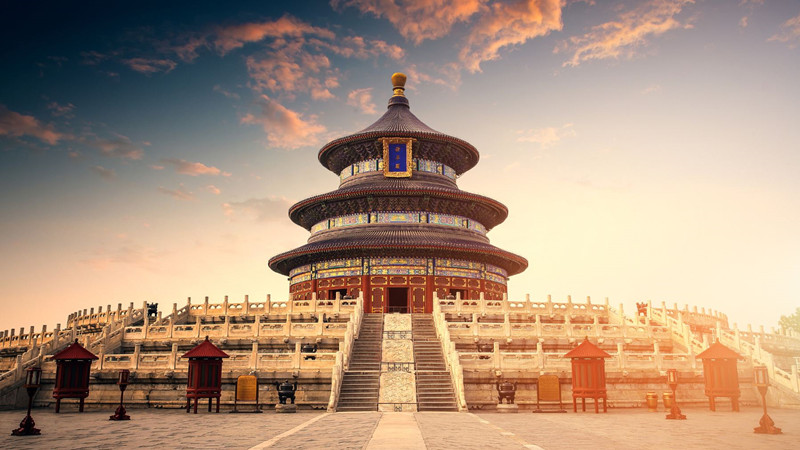The Temple of Heaven is a dedicated altar for emperors of the Ming and Qing dynasties to offer sacrifices to the heavens, pray for rain, and pray for a prosperous year. It is a famous ancient building in China. The northern part of the Altar Domain is circular, while the southern part is square, symbolizing "the sky is round and the place is round". The entire Temple of Heaven is divided into two parts: the Inner Altar and the Outer Altar. The well-known buildings such as the Prayer Hall and the Echo Wall are all located in the Inner Altar.
Regional Overview
The inner altar is divided into two parts, north and south, with the northern part being the "Prayer for Grain Altar". It is the place where the emperor holds the Prayer for Grain Ceremony in spring, praying for favorable weather and abundant grain. The main buildings include the Prayer for Good Harvest Hall, Emperor Qiandian Hall, East West Auxiliary Hall, Prayer for Good Harvest Gate, Divine Kitchen, Sacrificial Animal Pavilion, and 72 Long Corridor.

The southern part is known as the "Circular Hill Altar", which is an open-air three story circular stone altar. It is a place for the emperor to worship the heavens on the winter solstice, and the main buildings include the Circular Hill Altar, the imperial dome and its supporting halls, the divine kitchen, the three warehouses, and the slaughterhouse pavilion.
Connecting the two altars is a brick and stone platform 360 meters long, 28 meters wide, and 2.5 meters high, known as the "Shinto Road", also known as the "Haiman Avenue", or the "Danshi Bridge", symbolizing the long road that needs to be passed before reaching the Heavenly Court.
The Exquisite Design of Sanyin Stone
When visiting the Temple of Heaven, in addition to admiring the exquisite architecture of various halls and pursuing the grand scene of ancient emperors offering sacrifices to the heavens, the ingenious designs such as the Echo Wall and the Three Tone Stone also make people marvel at the wisdom of the ancients.
On the flagstone road from the front of the Imperial Dome Hall to the middle of the gate, the three flagstones from north to south are called Sanyin Stone. With the doors and windows of the Imperial Dome closed and there are no obstacles nearby, standing on the first stone slab and clapping, an echo can be heard; Clap your hands on the second slate and hear two echoes; High fives on the third slate, and three echoes can be heard.
Understanding the Culture of Sacrifice to Heaven
A simple visit may not have a specific concept for the ancient emperor's sacrificial ceremony. Never mind, the sacrificial ceremony hall located in the west side hall of the Prayer for Good Harvest Hall provides a detailed introduction to the evolution of Chinese sacrificial rituals, with a focus on showcasing the ceremonial situation of the Qing Dynasty's sacrificial ceremony, including various sacrificial vessels and procedures. Among them, the "Picture of the Great Drive of the Thirteenth Year of the Qianlong reign of the Qing Dynasty" first showcases the style of Chinese royal ceremonial guards, which is particularly exciting and cannot be missed.
The sacrificial music and dance hall located in the east side hall of the Prayer for Good Harvest Hall provides a comprehensive introduction to the historical evolution, music and dance systems, management institutions, and performance scenes of the Zhonghe Shao Music in the Qing Dynasty, using instruments such as chimes and chimes, combined with text and pictures. This provides visitors with an intuitive and comprehensive understanding of the sacrificial music and dance.
Travel Tips
Address: A1 Tiantan Road, Dongcheng District, Beijing
Tel: 010-67012483010-67013036
Official website: http://www.tiantanpark.com/
Opening Hours: 08:00-18:00
Ticket price: CNY15
